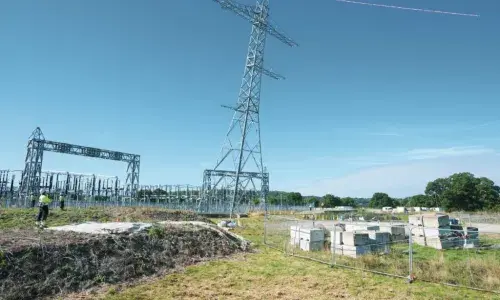
Powering up Christmas: 12 Festive Facts from National Grid
The countdown to Christmas has officially begun, and with just 14 sleeps to go until the big day, National Grid has revealed the numbers that make Christmas electrical!
- To cook the nation’s 8.5 million turkeys, we use over 63 GWh of energy, which is the equivalent of powering 23,500 homes annually.
- As the nation starts to light its Christmas trees, in the first week of December, electricity demand rose by approximately 7.3%
- More than 360 National Grid employees will work over 11,600 hours this Christmas to keep the lights on
- Christmas Day is the only day of the year that the UK energy peak is not at teatime and is at lunchtime.
- Over the last two years renewable energy has been around half of the electricity mix on Christmas Day.
The countdown to Christmas has officially begun, and with just 14 sleeps to go until the big day, National Grid has revealed the numbers that make Christmas electrical!
From Christmas lights to Christmas dinner, many British festive traditions wouldn’t be possible without electricity. To celebrate the critical role this incredible energy source plays in powering Christmas, National Grid has released 12 dazzling facts behind the festivities, from the cost of lighting a tree, to powering those new games consoles, and the number of people who’ll be working on Christmas day to keep the lights on.
National Grid sits at the heart of Britain’s energy system, connecting millions of people and businesses to the energy they use every day. Its networks comprise 4,500 miles of overhead line, 1,500 miles of underground cable and 300 plus substations, whilst the distribution network has 60,000 miles of overhead line and 89,900 miles of underground cable.
Alice Delahunty, President of National Grid Electricity Transmission, said: “Electricity is something that can be easily taken for granted, and yet it impacts almost every aspect of our lives, not least at Christmas time. As we decorate our homes and put lights on the tree, cook Christmas dinner and watch or stream TV, it’s worth remembering that none of it would be possible without electricity. And while demand on Christmas day is lower than usual, we do get an insight into the nation’s habits with a spike in demand as ovens switch on for the festive feast.
“National Grid connects millions of people to the energy they use every day, and our colleagues work 24/7 to keep the lights on. Christmas is no different with 360 of our team working throughout Christmas Day and Boxing Day to ensure safe, secure and reliable electricity makes the festivities possible. In fact, you could say it’s the people working over the Christmas period at National Grid, that make Christmas truly sparkle and I would like to thank every single one of them.”
1. ‘O Christmas Tree’ – National Grid’s data experts have been crunching the numbers and based on previous year’s data, demand for electricity rose by 7.3% in the first week of December, as the nation turns on its Christmas lights.
In the UK, people start to put up their Christmas trees from the fourth Sunday before Christmas, which this year was Sunday 3rd December, providing 34 days of twinkling lights until the twelfth night or 6th January.
2. ‘Christmas Lights’ – If every UK household celebrating Christmas (approximately 25 million homes) strung a single chain of Christmas lights all in a row, we would have approximately 150,000 miles of lights, that’s enough to illuminate the British coastline twenty times over.
3. ‘Rocking Around the Christmas Tree’ – It costs approximately 55p to light our trees with LED lights for six hours a day throughout the entire festive period. For those using the incandescent variety, the cost is over four times that, rising to just over £2 for the same amount of time. Delaying turning the lights on by just one week saves approximately 11p per household.
4. ‘Christmas Time’ – The energy peak for Christmas dinner is at approximately 12:45, with peak electricity demand between 12:20 and 13:15, as we get our Christmas cook on. In fact, it’s the only day of the year that the energy peak is not at teatime.
And while some may consume more food than normal at Christmas, consumption of electricity actually falls on Christmas Day, the reason being that very few businesses and industrial premises are working. In fact, over the last two years, Christmas Day was one of the five lowest demand days for electricity consumption over the course of the four of the coldest months – January, February, November, and December.
5. ‘HO! HO! HO! Who’d be a Turkey at Christmas?' – Turkey remains the meal of choice for most Christmas dinners and according to the British Poultry Council, we buy a massive 8 to 9 million of them in the run up to the big day. To cook to perfection, it takes roughly three hours and costs the average home £2. To cook 8.5 million turkeys, it takes 63 GWh of energy, or enough energy to power 23,500 homes annually. In fact, putting a turkey in the oven for one hour uses the equivalent amount of energy as lighting a single string of Christmas lights for six hours.
6. ‘Baby It’s Cold Outside’ – We Brits love our gadgets with 65% of people admitting that they spend five hours or more cosying up with their electric gadgets over Christmas Day and Boxing Day. In fact, games consoles are some of the top selling items on Black Friday, with an estimated two million sold in 2022. If all two million games consoles were played for just one hour, they would use 180MWh of electricity, or enough to power 24,000 homes for a single day.
7. ‘Driving Home for Christmas’ – Spare a little thought for the estimated 360 National Grid employees that will be working on Christmas Day and Boxing Day to ‘keep our lights on’. Over the 48-hour period, they will be covering more than 11,600 working hours between them, that’s over 483 days.
8. ‘Chestnuts Roasting On An Open Fire’? – Did you know that the way we cook Christmas dinner can help us to save energy and money? Keeping the lids on your pans as you cook uses 10% less energy than if they were removed.
9. ‘All I Want for Christmas Is You’ – Consider adding smart plugs or timers to next year’s Christmas list. From TVs and set-top boxes to games consoles, soundbars and phone chargers, leaving things on stand-by all adds up. In fact, we estimate that if the country switched all TVs off standby, it could save a collective £14 million and over 50GWh of power annually, which is the equivalent to the annual energy consumption of more than 19,000 homes.
10. ‘I’m Dreaming of a Green Christmas’ – In the ten years from 2013 to 2022, the carbon intensity of the grid (the volume of carbon dioxide released into the atmosphere to produce a kilowatt hour (kWh) of electricity) on Christmas Day has been reduced by five times, with 2021 ranking the lowest for emissions. In fact, for the last two years (2021 and 2022), renewable energy sources (like wind and solar) have represented an average of 49% of the electricity mix on Christmas Day, with wind representing just 0.3% of the mix in 2008. Since last year, the UK has also installed 1.8GW more wind capacity.
11. ‘White Christmas’ – The song a ‘White Christmas’ may be topping the Christmas song charts but the top internet searches in the last week of November have been the number of days until Christmas, with 281,660 searches. There are also lots of eager Father Christmas spotters out there, with 33,700 searches for where is Father Christmas right now?
12. ‘Last Christmas’ – Last year, National Grid launched its £50 million Energy Support Fund to help alleviate the financial distress caused by rising energy costs. The fund aims to support five charities over the course of two winters helping households across the country by providing immediate, emergency relief to families on prepayment meters, providers of advisory services for households struggling with energy bills, payments and debts, and fund energy efficiency measures to help households lower their bills.
Alice Delahunty at National Grid continued: “It may be the most wonderful time of the year for many people, but for others it can be challenging, not least during the cost-of-living crisis. Last year, we launched the £50 million National Grid Energy Support Fund, supporting five charity partners across two winters to help combat fuel poverty and the cost-of-living crisis.
“There are ways that people can make savings this Christmas including switching to LED lights and considering the introduction of smart plugs and timers. For those looking for advice, please do contact one of our charity partners Citizens Advice, National Energy Action, National Energy Foundation, the Fuel Bank Foundation or Affordable Warmth Solutions who can provide further support.”
National Grid wishes everyone a Merry Christmas.”
ENDS


